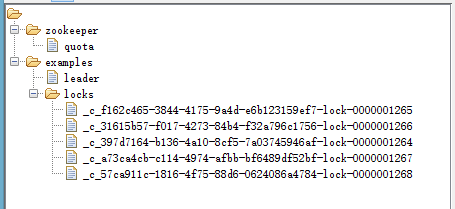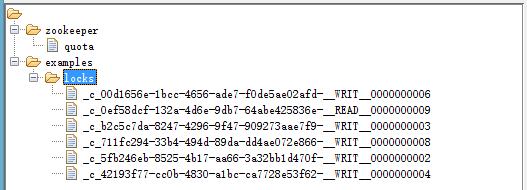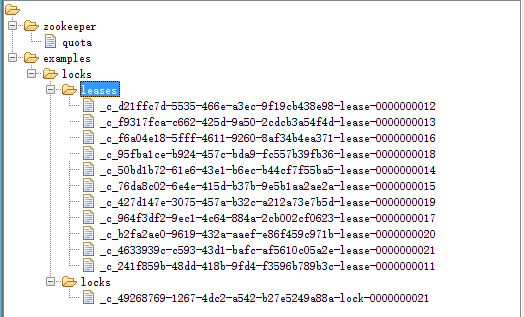锁:分布式的锁全局同步,这意味着任何一个时间点不会有两个客户端都拥有相同的锁。
1.可重入锁Shared Reentrant Lock
首先我们先看一个全局可重入的锁(可以多次获取,不会被阻塞)。Shared意味着锁是全局可见的,客户端都可以请求锁。Reentrant和JDK的ReentrantLock类似,意味着同一个客户端在拥有锁的同时,可以多次获取,不会被阻塞。
1.可重入锁相关类介绍
它是由类InterProcessMutex来实现。它的主要方法:
// 构造方法public InterProcessMutex(CuratorFramework client, String path)public InterProcessMutex(CuratorFramework client, String path, LockInternalsDriver driver)// 通过acquire获得锁,并提供超时机制:public void acquire() throws Exceptionpublic boolean acquire(long time, TimeUnit unit) throws Exception// 撤销锁public void makeRevocable(RevocationListener<InterProcessMutex> listener)public void makeRevocable(final RevocationListener<InterProcessMutex> listener, Executor executor)
错误处理:还是强烈推荐你使用ConnectionStateListener处理连接状态的改变。当连接LOST时你不再拥有锁。
2.编写示例程序
首先让我们创建一个模拟的共享资源, 这个资源期望只能单线程的访问,否则会有并发问题。
public class FakeLimitedResource{private final AtomicBoolean inUse = new AtomicBoolean(false);// 模拟只能单线程操作的资源public void use() throws InterruptedException{if (!inUse.compareAndSet(false, true)){// 在正确使用锁的情况下,此异常不可能抛出throw new IllegalStateException("Needs to be used by one client at a time");}try{Thread.sleep((long) (3 * Math.random()));}finally{inUse.set(false);}}}
然后创建一个ExampleClientThatLocks类,它负责请求锁,使用资源,释放锁这样一个完整的访问过程。
public class ExampleClientThatLocks{private final InterProcessMutex lock;private final FakeLimitedResource resource;private final String clientName;public ExampleClientThatLocks(CuratorFramework client, String lockPath, FakeLimitedResource resource, String clientName){this.resource = resource;this.clientName = clientName;lock = new InterProcessMutex(client, lockPath);}public void doWork(long time, TimeUnit unit) throws Exception{if (!lock.acquire(time, unit)){throw new IllegalStateException(clientName + " 不能得到互斥锁");}try{System.out.println(clientName + " 已获取到互斥锁");resource.use(); // 使用资源Thread.sleep(1000 * 1);}finally{System.out.println(clientName + " 释放互斥锁");lock.release(); // 总是在finally中释放}}}
最后创建主程序来测试:
public class InterProcessMutexExample{private static final int QTY = 5;private static final int REPETITIONS = QTY * 10;private static final String PATH = "/examples/locks";public static void main(String[] args) throws Exception{final FakeLimitedResource resource = new FakeLimitedResource();final List<CuratorFramework> clientList = new ArrayList<CuratorFramework>();for (int i = 0; i < QTY; i++){CuratorFramework client = CuratorFrameworkFactory.newClient("127.0.0.1:2181", new ExponentialBackoffRetry(1000, 3));client.start();clientList.add(client);}System.out.println("连接初始化完成!");ExecutorService service = Executors.newFixedThreadPool(QTY);for (int i = 0; i < QTY; ++i){final int index = i;Callable<Void> task = new Callable<Void>(){@Overridepublic Void call() throws Exception{try{final ExampleClientThatLocks example = new ExampleClientThatLocks(clientList.get(index), PATH, resource, "Client " + index);for (int j = 0; j < REPETITIONS; ++j){example.doWork(10, TimeUnit.SECONDS);}}catch (Throwable e){e.printStackTrace();}finally{CloseableUtils.closeQuietly(clientList.get(index));}return null;}};service.submit(task);}service.shutdown();service.awaitTermination(10, TimeUnit.MINUTES);System.out.println("OK!");}}
代码也很简单,生成5个client,每个client重复执行10次 请求锁--访问资源--释放锁的过程。每个client都在独立的线程中。
结果可以看到,锁是随机的被每个实例排他性的使用。
既然是可重入锁,你可以在一个线程中多次调用acquire,在线程拥有锁时它总是返回true。
注意:你不应该在多个线程中用同一个InterProcessMutex, 你可以在每个线程中都生成一个InterProcessMutex实例,它们的path都一样,这样它们可以共享同一个锁。
3.示例运行结果
运行结果控制台如下:
连接初始化完成!Client 4 已获取到互斥锁Client 4 释放互斥锁Client 3 已获取到互斥锁Client 3 释放互斥锁......Client 2 已获取到互斥锁Client 2 释放互斥锁OK!
运行时查看Zookeeper节点信息如下:

2.不可重入锁Shared Lock
这个锁和上面的相比,就是少了Reentrant的功能,也就意味着它不能在同一个线程中重入。这个类是InterProcessSemaphoreMutex使用方法和上面的类类似
首先我们将上面的例子修改一下,测试一下它的重入。修改ExampleClientThatLocks.doWork,连续两次acquire:
public void doWork(long time, TimeUnit unit) throws Exception{if (!lock.acquire(time, unit)){throw new IllegalStateException(clientName + " 不能得到互斥锁");}System.out.println(clientName + " 已获取到互斥锁");if (!lock.acquire(time, unit)){throw new IllegalStateException(clientName + " 不能得到互斥锁");}System.out.println(clientName + " 再次获取到互斥锁");try{resource.use(); // 使用资源Thread.sleep(1000 * 1);}finally{System.out.println(clientName + " 释放互斥锁");lock.release(); // 总是在finally中释放lock.release(); // 获取锁几次 释放锁也要几次}}
注意:我们也需要调用release两次。这和JDK的ReentrantLock用法一致。如果少调用一次release,则此线程依然拥有锁。
上面的代码没有问题,我们可以多次调用acquire,后续的acquire也不会阻塞。
但是将上面的InterProcessMutex换成不可重入锁InterProcessSemaphoreMutex,如果再运行上面的代码,结果就会发现线程被阻塞在第二个acquire上,直到超时。也就是此锁不是可重入的。
3.可重入读写锁Shared Reentrant Read Write Lock
类似JDK的ReentrantReadWriteLock。一个读写锁管理一对相关的锁。一个负责读操作,另外一个负责写操作。读操作在写锁没被使用时可同时由多个进程使用,而写锁在使用时不允许读(阻塞)。
此锁是可重入的。一个拥有写锁的线程可重入读锁,但是读锁却不能进入写锁。这也意味着写锁可以降级成读锁, 比如请求写锁 --->读锁 ---->释放写锁。从读锁升级成写锁是不行的。
1.可重入读写锁相关类介绍
可重入读写锁主要由两个类实现:InterProcessReadWriteLock、InterProcessMutex。使用时首先创建一个InterProcessReadWriteLock实例,然后再根据你的需求得到读锁或者写锁,读写锁的类型是InterProcessMutex。

2.编写示例程序
示例程序仍使用上面的FakeLimitedResource、InterProcessMutexExample类
public class ExampleClientReadWriteLocks{private final InterProcessReadWriteLock lock;private final InterProcessMutex readLock;private final InterProcessMutex writeLock;private final FakeLimitedResource resource;private final String clientName;public ExampleClientReadWriteLocks(CuratorFramework client, String lockPath, FakeLimitedResource resource, String clientName){this.resource = resource;this.clientName = clientName;lock = new InterProcessReadWriteLock(client, lockPath);readLock = lock.readLock();writeLock = lock.writeLock();}public void doWork(long time, TimeUnit unit) throws Exception{// 注意只能先得到写锁再得到读锁,不能反过来!!!if (!writeLock.acquire(time, unit)){throw new IllegalStateException(clientName + " 不能得到写锁");}System.out.println(clientName + " 已得到写锁");if (!readLock.acquire(time, unit)){throw new IllegalStateException(clientName + " 不能得到读锁");}System.out.println(clientName + " 已得到读锁");try{resource.use(); // 使用资源Thread.sleep(1000 * 1);}finally{System.out.println(clientName + " 释放读写锁");readLock.release();writeLock.release();}}}
在这个类中我们首先请求了一个写锁,然后降级成读锁。执行业务处理,然后释放读写锁。修改InterProcessMutexExample类中的ExampleClientThatLocks为ExampleClientReadWriteLocks然后运行示例。
3.示例运行结果
运行结果控制台:
连接初始化完成!Client 1 已得到写锁Client 1 已得到读锁Client 1 释放读写锁......Client 3 已得到写锁Client 3 已得到读锁Client 3 释放读写锁OK!
此时查看Zookeeper数据节点如下:

4.信号量Shared Semaphore
一个计数的信号量类似JDK的Semaphore。JDK中Semaphore维护的一组许可(permits),而Cubator中称之为租约(Lease)。
有两种方式可以决定semaphore的最大租约数。第一种方式是有用户给定的path决定。第二种方式使用SharedCountReader类。
如果不使用SharedCountReader,没有内部代码检查进程是否假定有10个租约而进程B假定有20个租约。 所以所有的实例必须使用相同的numberOfLeases值.
1.信号量实现类说明
主要类有:
- InterProcessSemaphoreV2 - 信号量实现类
- Lease - 租约(单个信号)
- SharedCountReader - 计数器,用于计算最大租约数量
这次调用acquire会返回一个租约对象。客户端必须在finally中close这些租约对象,否则这些租约会丢失掉。但是,如果客户端session由于某种原因比如crash丢掉,那么这些客户端持有的租约会自动close,这样其它客户端可以继续使用这些租约。
租约还可以通过下面的方式返还:
public void returnLease(Lease lease)public void returnAll(Collection<Lease> leases)
注意一次你可以请求多个租约,如果Semaphore当前的租约不够,则请求线程会被阻塞。同时还提供了超时的重载方法。
public Lease acquire() throws Exceptionpublic Collection<Lease> acquire(int qty) throws Exceptionpublic Lease acquire(long time, TimeUnit unit) throws Exceptionpublic Collection<Lease> acquire(int qty, long time, TimeUnit unit) throws Exception
2.编写示例程序
public class InterProcessSemaphoreExample{private static final int MAX_LEASE = 10;private static final String PATH = "/examples/locks";public static void main(String[] args) throws Exception{FakeLimitedResource resource = new FakeLimitedResource();CuratorFramework client = CuratorFrameworkFactory.newClient("127.0.0.1:2181", new ExponentialBackoffRetry(1000, 3));client.start();InterProcessSemaphoreV2 semaphore = new InterProcessSemaphoreV2(client, PATH, MAX_LEASE);Collection<Lease> leases = semaphore.acquire(5);System.out.println("获取租约数量:" + leases.size());Lease lease = semaphore.acquire();System.out.println("获取单个租约");resource.use();Collection<Lease> leases2 = semaphore.acquire(5, 10, TimeUnit.SECONDS);System.out.println("获取租约,如果为空则超时: " + leases2);System.out.println("释放租约");semaphore.returnLease(lease);System.out.println("释放集合中的所有租约");semaphore.returnAll(leases);client.close();System.out.println("OK!");}}
首先我们先获得了5个租约,接着请求了一个租约,因为semaphore还有5个租约,所以请求可以满足,返回一个租约,还剩4个租约。
然后再请求一个租约,因为租约不够,阻塞到超时,还是没能满足,返回结果为null。
3.示例运行结果
运行结果控制台如下:
获取租约数量:5获取单个租约获取租约,如果为空则超时: null释放租约释放集合中的所有租约OK!
此时查看Zookeeper数据节点如下:

注意:上面所讲的4种锁都是公平锁(fair)。从ZooKeeper的角度看,每个客户端都按照请求的顺序获得锁。相当公平。
5.多锁对象 Multi Shared Lock
Multi Shared Lock是一个锁的容器。当调用acquire,所有的锁都会被acquire,如果请求失败,所有的锁都会被release。同样调用release时所有的锁都被release(失败被忽略)。基本上,它就是组锁的代表,在它上面的请求释放操作都会传递给它包含的所有的锁。
1.主要类说明
主要涉及两个类:
- InterProcessMultiLock - 对所对象实现类
- InterProcessLock - 分布式锁接口类
它的构造函数需要包含的锁的集合,或者一组ZooKeeper的path。用法和Shared Lock相同。
public InterProcessMultiLock(CuratorFramework client, List<String> paths)public InterProcessMultiLock(List<InterProcessLock> locks)
2.编写示例程序
public class InterProcessMultiLockExample{private static final String PATH1 = "/examples/locks1";private static final String PATH2 = "/examples/locks2";public static void main(String[] args) throws Exception{FakeLimitedResource resource = new FakeLimitedResource();CuratorFramework client = CuratorFrameworkFactory.newClient("127.0.0.1:2181", new ExponentialBackoffRetry(1000, 3));client.start();InterProcessLock lock1 = new InterProcessMutex(client, PATH1); // 可重入锁InterProcessLock lock2 = new InterProcessSemaphoreMutex(client, PATH2); // 不可重入锁InterProcessMultiLock lock = new InterProcessMultiLock(Arrays.asList(lock1, lock2));if (!lock.acquire(10, TimeUnit.SECONDS)){throw new IllegalStateException("不能获取多锁");}System.out.println("已获取多锁");System.out.println("是否有第一个锁: " + lock1.isAcquiredInThisProcess());System.out.println("是否有第二个锁: " + lock2.isAcquiredInThisProcess());try{resource.use(); // 资源操作}finally{System.out.println("释放多个锁");lock.release(); // 释放多锁}System.out.println("是否有第一个锁: " + lock1.isAcquiredInThisProcess());System.out.println("是否有第二个锁: " + lock2.isAcquiredInThisProcess());client.close();System.out.println("OK!");}}
新建一个InterProcessMultiLock,包含一个重入锁和一个非重入锁。调用acquire后可以看到线程同时拥有了这两个锁。调用release看到这两个锁都被释放了。
注意:再重申一遍,强烈推荐使用ConnectionStateListener监控连接的状态。
3.示例运行结果
运行结果控制台如下:
已获取多锁是否有第一个锁: true是否有第二个锁: true释放多个锁是否有第一个锁: false是否有第二个锁: falseOK!
此时查看Zookeeper数据节点如下:



 浙公网安备 33010602011771号
浙公网安备 33010602011771号